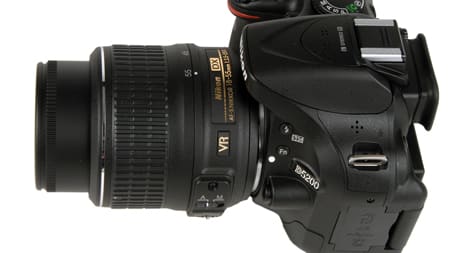Head to Head: Nikon D5200 vs. D3200
Nikon offers two outstanding entry-level DSLRs, but which one is perfect for you?
 Credit:
Credit:
Products are chosen independently by our editors. Purchases made through our links may earn us a commission.
Editor's note: Nikon has since updated both of its entry-level DSLRs, releasing the D3300 and the D5300. We are currently in the process of reviewing both cameras, but you can check out our first impressions of the D3300 here and our first impressions of the D5300 right here.
If a consumer wants to step up to an entry-level DSLR, and they're already dead set on a Nikon, their purchase decision could easily boil down to this simple dichotomy: "Should I buy the D5200 (MSRP $899.95), or the D3200 (MSRP $599.95)?" On paper, the two cameras look pretty darn similar. They've got the same resolution, the same kit lens, the same shape, and many of the same features. Yet the D5200 kit is selling for $300 more. Why? And, more importantly, which one is the better value? We'll help you decide.
Ultimately (and we're sort of spoiling the ending already, but here goes...), we want to emphasize that the key differences between these two models are all features, not performance metrics. Internally, these two are almost the same camera, but a few convenience and control options set them apart. The good news is, at least in this case, that the consumer always wins. Either your shooting habits will justify the D5200's higher—yet still reasonable—cost, or the D3200 will be a perfect chance to save some cash.
To read our full-length, in-depth review of the Nikon D5200, click here. To read our full-length, in-depth review of the Nikon D3200, click here.
Performance
To add some detail to our point above, the D5200 and D3200 share a very similar performance profile. Sharpness results were close enough to be within our test's margin of error, and the same was true for both color accuracy and dynamic range. The D3200 was penalized slightly for its less flexible noise reduction options, but pure performance was again almost identical.
Differences in performance, when they did occur, were always minor. The D5200 had an imperceptible advantage in white balance accuracy, and captures videos ever-so-slightly sharper than the D3200. The more expensive camera also has a slightly quicker continuous shooting speed, but only by 0.7 frames per second.
Features
Here's where the D5200 and D3200 really diverge. At a glance, the two bodies look pretty similar, yet subtle changes lead to big differences between in shooting experience. The most obvious difference is the D5200's swing-out, rotating LCD which—despite having the same resolution as the D3200's panel—will be much more compelling for videographers, who often need to frame their shots from the hip, overhead, or even in front of the camera.
Since this monitor takes up more space, the column of buttons to the left of the D3200's rear panel is no longer feasible. Instead, Nikon has scattered those buttons around the D5200's body in a new—and, we think, better—arrangement. The placement of the "i" shortcut key, playback button, and live-view lever make the D5200 a much easier camera to hold and use, especially one-handed.
The D5200's superior convenience extends to the camera's software as well. Although both models are using a version of Nikon's old and not particularly intuitive menu system, the D3200 lacks a Custom Setting Menu tab entirely, making this camera's settings far less detailed and customizable. Some beginners may therefore find the D3200 more accessible, but we just found it more restrictive.
Speaking of accessibility, both cameras feature extensive in-camera help, as well as helpful visualizations of the aperture iris, so it's easy for newcomers to understand what's going on with their camera at any given time.
One feature hidden from plain sight, yet still critically important, is autofocus. Once again, the more expensive D5200 has the advantage here. It's equipped with 39 phase-detection autofocus points, and all 39 of them have 3D tracking capability for improved focus on moving objects. The D3200 has only 11 points, and is a lot less suitable for action photography.
Conclusion
Ask yourself how you plan on using this new camera, because there's a good chance you can save some money here. If you intend to spend a large portion of your shooting time on videos, then the D5200 is probably worth the extra cash for that swiveling LCD alone. Likewise, if you are—or want to be—an action photographer, then you'll greatly benefit from the D5200's new autofocus system. If not, question whether any of the following are worth $300: a somewhat more convenient button layout, extra details in the menu system, and a few insignificant performance advantages. Our thoughts? No, no, and no.
The D3200 is an excellent entry-level camera, and the D5200 is an excellent entry-level/mid-range camera. You can't go wrong with either one. So, our advice is to figure out how much camera you really need, get the model that suits you best, and then spend whatever cash remains on quality lenses.
